Netting | Backyard fruit tree nets pose deadly threat to bat species
Animal rescuers have urged the public to stop using wide-holed nets on fruit trees because they are killing and maiming native bats.
Tamsyn Hogarth, who runs the Fly By Night wildlife shelter in Olinda, calls it "slice-and-dice netting".
Shelter volunteers say they are caring for 55 juvenile grey-headed flying foxes, many of them orphans, while the bats heal from deep cuts, holes in wings, limb amputations, malnutrition and neck lacerations.
A further 50 adults the centre has rescued are in the homes of volunteer carers.
Many injuries are from the bats desperately trying to untangle themselves from nets, and babies are dying because their mothers are not returning to feed them owing to injury or death.
Experts say habitat destruction has led to the species being classed as "threatened". But Ms Hogarth says heavy rain and unseasonable spring prevented the bats' food source, eucalypt flowers, from blooming. This has driven them to backyard fruit trees.
If the holes of the nets protecting the fruit are big enough to put a finger into the bats can get caught and can struggle in agony for days. Advice on safe netting is available from the Wildlife Friendly Fencing project.
Melbourne Zoo vet Sarah Frith said anyone who found a bat should not touch it, because scratches could cause disease and infection. They should call Wildlife Victoria on 1300 094 535, and a rescuer will collect the bat.
Fly By Night volunteers have rescued bats from as far afield as Bairnsdale and Colac.
The bats are treated by Melbourne Zoo and Healesville Sanctuary vets, then nursed at Fly By Night or in carers' homes until their release into the wild in Kew.
Dr Frith said in the past 15 years, the two zoos had seen more than 500 bats, of which 64 per cent were injured because of human behaviour.
She said 37 per cent were found tangled in fruit netting, but she believes that is an underestimation because a further 28 per cent had injuries "consistent with fruit netting, but they just weren't found there".
Others were caught on barbed wire, electrocuted on power wires, shot, attacked by pets or hit by cars.
Dr Frith urged suburban gardeners to use finely woven wildlife-friendly netting, drawn taut on a frame. It should be white so the bats can see it.
She said that in the past three years, the zoos had treated up to 100 bats a year. In previous years "you would be lucky to see 30", she said.
"It's really serious. We're seeing it escalate every year, these last couple of years, and it's a real worry for such a threatened population. It just seems like something that's so preventable."
Grey-headed flying foxes were "very important in terms of pollination for plants and crucial for the ecosystem in Victoria", she said.
"If people realised what damage was being done just by the wrong choice of product, I think they would definitely choose something different."












COMMENTS